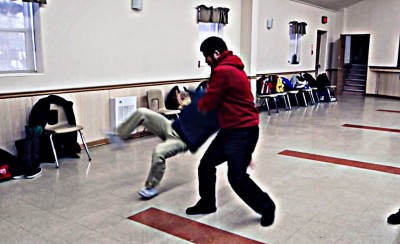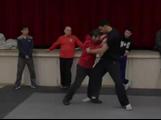Click on the picture above to go to the video. Please leave comments in the reply video section.
The important components: 1. Having 2 lines, 2. Having separation 3. Resolve through rotation (one line is the catch or lock and the rotation provides the other action for the other line). Click on the gif
I’ll show you the lines.
“If you only have one line, you’re going back and forth.” In this video Master Chen teaches how to create two separate lines to “cut” an opponent like a pair of scissors. Below Master Chen created 2 lines on Kelvin as indicated by the red arrows. These lines are independent from one another yet work together. Clearly upper body and lower body separation is a prerequisite for this to work. Please refer to the video to see what happens after these two lines “cut”. Notice the lower line is fixed (it’s a lock) and the upper line cuts by way of waist rotation.
Click on the GIF to see the “cut”. Do you see the 2 lines crossing?
The Second picture Master Chen establishes 2 separate lines on Hugo. The difference is the line on top is fixed and the line on the bottom does the “cutting”.
Below click on the gif to see cut. Can you see the lines cross? Since the top is locked and the bottom provides the action, Hugo’s lower body is cut out underneath him.
Can you find the lines?
With this student, Master Chen uses different angles. Where are the lines and where is the cut? Click on the gif to see or watch video.
When Master Chen does the move on Brennan, instead of lines, he does it with spirals…remember, a spiral is a stretch (line) with a rotation. Can you see the two spirals? Click on gif…this is more difficult to see!
This cut Master Chen does on Hugo is very small, subtle and precise…it is hard to see…can you see it? Click on the gif.











{ 1 comment… read it below or add one }
Thank you John Upshaw for creating the gifs and the images with the lines. They are excellent teaching tools. You hit the nail right on the head and, with the images, you made everything more clear! This is Master Chen Zhonghua’s basic brick with respect to skill building (“always add”) and training. By the way, I typically think in terms of lines, planes and orthogonality. And, as you suggested, the spiral has all these…even just with an extending/stretching arm rotating out.